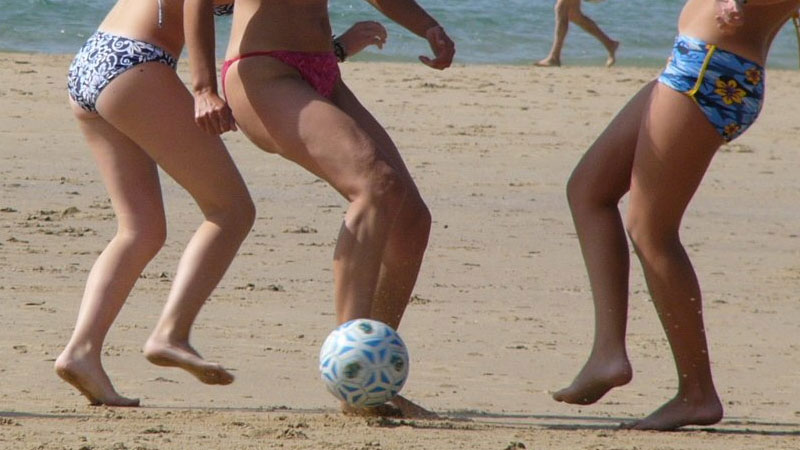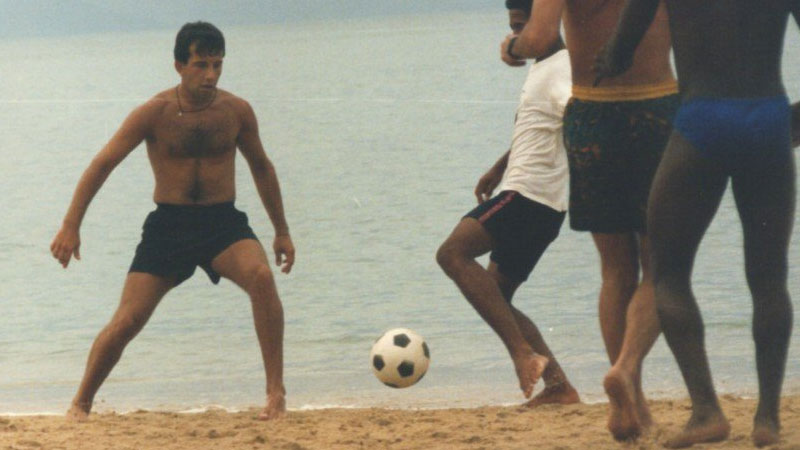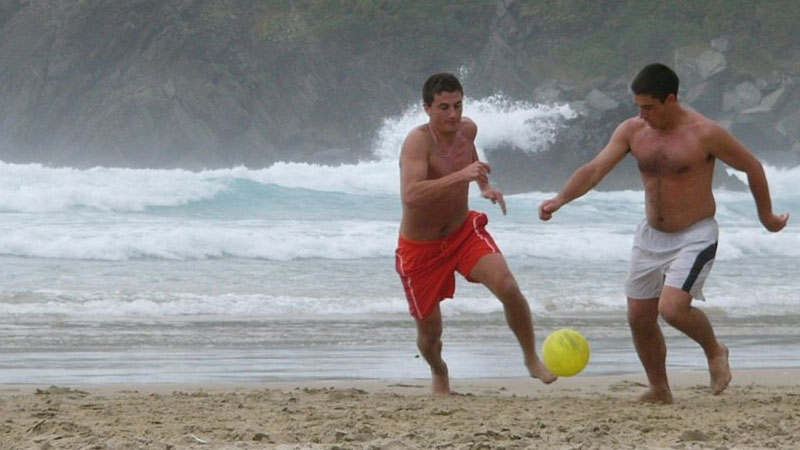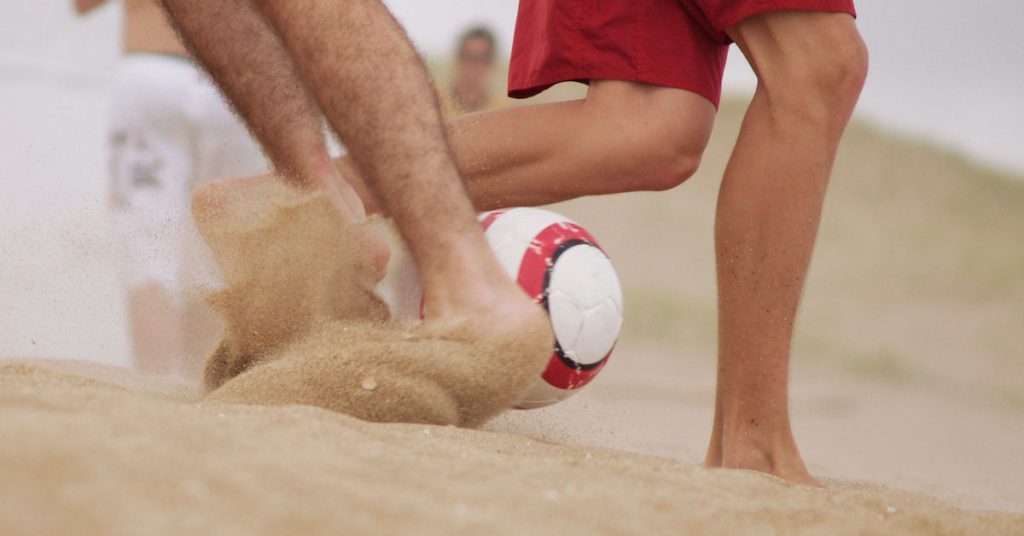Authority Soccer (authoritysoccer.com) is a participant in the Amazon Services LLC Associates Program, an affiliate advertising program designed to provide a means for sites to earn advertising fees by advertising and linking to Amazon.com. This site also participates in other affiliate programs and is compensated for referring traffic and business to them.
Beach soccer is one of the fastest-growing sports in the world. It is enjoyed by children, men, and women around the globe, in all climates; regardless of whether there are sand and beaches there naturally or not.
While drawing a lot of influence from regular soccer, beach soccer is played on a smaller field, with just 5 players on each side, and with no shoes.
One additional important question is commonly brought with beach soccer: Are beach soccer balls different?
While similar to regular soccer balls, beach soccer balls are somewhat different. The difference is seen in the texture of the ball’s surface, as well as its weight.
Beach soccer, however, can be played with a regular soccer ball, even in a professional environment. In this case, the ball needs to be inflated to lower pressure in order to meet the beach soccer requirements.
With the basics out of the way, the rest of this short article will deal with explaining the key differences between regular and beach soccer balls in more detail, as well as exploring some recent changes introduced to this essential piece of gear.
Are beach soccer balls different?

As we touched on briefly in the introduction, beach soccer balls are slightly different than the ones used in regular soccer. The main differences are in design, texture, and weight. What’s the purpose of these changes?
While we typically see a 32-panel design in regular soccer balls, purpose-made beach soccer balls are commonly created using a 6-panel build.
This means that the ball looks and feels much smoother, and allows it to be moved through the sand much easier. Beach soccer balls also usually come with a softer PU cover that is designed for barefoot play.
Beach soccer balls also tend to be bright-colored, most commonly yellow. As the sun glares in their eyes, beach soccer players need to be able to see the ball at all times, especially when it’s coming at them.
Beach soccer balls, especially those used in professional play, have a different texture from the balls used in grass and artificial turf soccer.
The change in texture is needed as beach soccer is played barefoot, while regular soccer players wear cleats that require a different texture to improve touch.
With the change in texture, beach soccer players are able to control the ball more easily on the sand, while not losing precision, touch, and feel.
The weight difference between beach and regular soccer balls is the most significant one. Beach soccer balls are much lighter than those used in regular soccer.
The first reason why the ball needs to be lighter in beach soccer is due to the fact that beach soccer players don’t wear shoes; the ball needs to be lighter so it can be kicked with no risk of injury.
Beach soccer play style is also much more different than in regular soccer; it mostly consists of high passes, as dribbling is extremely hard to perform on the sand.
This is the second reason why beach soccer balls need to be lighter; the passes are mostly received using the upper body or the players’ heads.
What kind of ball is used in beach soccer?

Even though there are purpose-maid beach soccer balls with different textures and entirely different technologies aimed at improving lightness than those used in regular soccer balls, beach soccer is most commonly played with a regular soccer ball that is deflated.
Most players that try beach soccer for the first time do so using the regular ball, and they stick with it. Even professional beach soccer matches are commonly played with a regular soccer ball.
According to the FIFA rulebook, there are strict rules that need to be followed in terms of the field area, goal size, sand depth, substitutes, and timing, but there’s no mention of official ball use, which means that any ball that is FIFA-approved can be used in beach soccer.
There’s one important rule for the ball used in beach soccer that needs to be followed in professional play, while it’s strongly advised to be followed by amateur players as well.
If you’re using a regular soccer ball to play beach soccer, it needs to be inflated to a lower pressure than usual. As beach soccer is mostly an aerial game, the ball needs to be lighter.
This means that it is pumped with air to 0.4-0.6 atm. In regular soccer, we typically inflate the ball much higher, 0.6-1.1 atm.
Why did they change the soccer ball?

While beach soccer can be played with a regular soccer ball that is deflated compared to the regular soccer ball, most professional tournaments have recently decided to change things up and start using the special beach soccer balls for their matches.
Why did they change the regular soccer balls when the rules allow for their use?
As mentioned throughout this article, and just like most recent changes in the world of soccer, the unofficial ball change in beach soccer is changed due to safety concerns.
Injury prevention is the first and foremost thing, as no one wants to see players injured, nor do they want to be liable for those injuries.
Even slightly reducing the risk of injury by introducing the ball that is specifically made for beach soccer is deemed worthy by the tournament organizers.
A lighter ball that is visible even in the brightest conditions means that there are far fewer cases of players being surprised by the ball and hurt.
Beach soccer is a fun game that many of us enjoy during summer vacation. However, for some soccer players, it is the main way of playing soccer.
While it can be enjoyed, both in amateur, semi-professional, and professional environments, using a soccer ball that is designed for grass, beach soccer is much safer, and much more fun, when it’s played with a ball that is specifically designed for this purpose.

